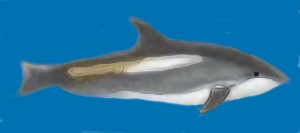The Atlantic white-sided dolphin or Lagenorhynchus acutus hangs out in the cold water of the north Atlantic Ocean. According to the Encyclopedia of Marine Mammals, this dolphin has been spotted as far south as Cape Cod, as far north as southern Iceland and as far east as the Norwegian Sea.
Considered to be one of the most colorful dolphins, the Atlantic white-sided dolphin has striking white stripes along the front sides underneath the eye and also a separate smaller white stripe on the side closer to the dorsal fin, this stripe extends towards the tail where it turns into a beautiful golden-brown. The rest of the body is a dark gray, sometimes almost black. The head slopes gently into a small beak giving the Atlantic white-sided dolphin a sleek aerodynamic look.
Since the Atlantic white-sided dolphin prefers the deep ocean and is found across the entire north Atlantic Ocean, it’s extemely difficult and costly to perform counts and document current population numbers. Scientists estimate that there are anywhere from 150,000 to 300,000. While NOAA estimates that there are close to 50,000 Atlantic white-sided dolphins regularly hanging out closer to the United States and Canada in the western Atlantic.
By taking a close look at the stomach contents of dolphins that have stranded or have been inadvertently caught in nets, scientists have determined that Atlantic white-sided dolphins eat several types of fish and squid, depending on which side of the Atlantic they call home. This healthy diet allows males to grow close to nine feet and weigh on average 500 pounds, while females are slightly shorter and lighter.
Atlantic white-sided dolphins seem to be doing pretty well, despite being killed in drive fisheries in Norway and Newfoundland in the past. Right now, gill nets and trawl nets are the biggest potential problems for Atlantic white-sided dolphins and they have been caught by both.
Keep on keeping on Atlantic white-sided dolphins and do your best to avoid those nasty fishing nets that catch everything within their path.

Leave a Reply